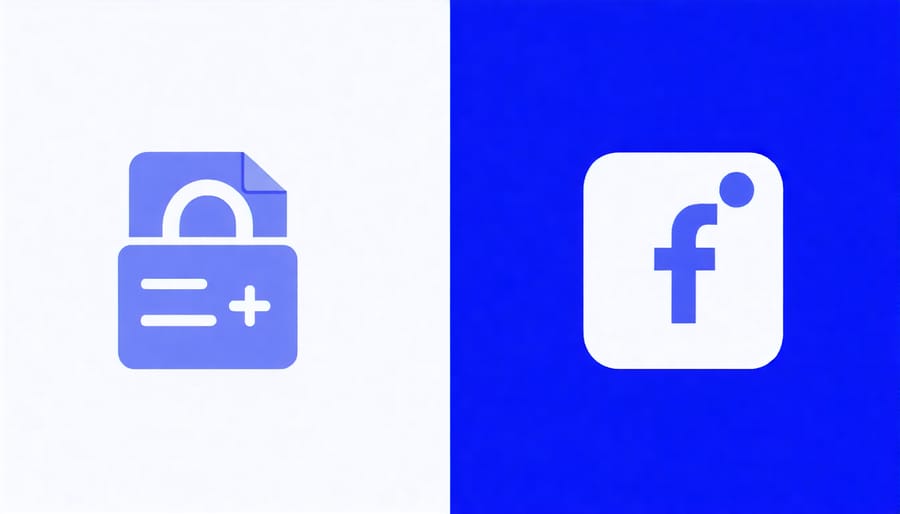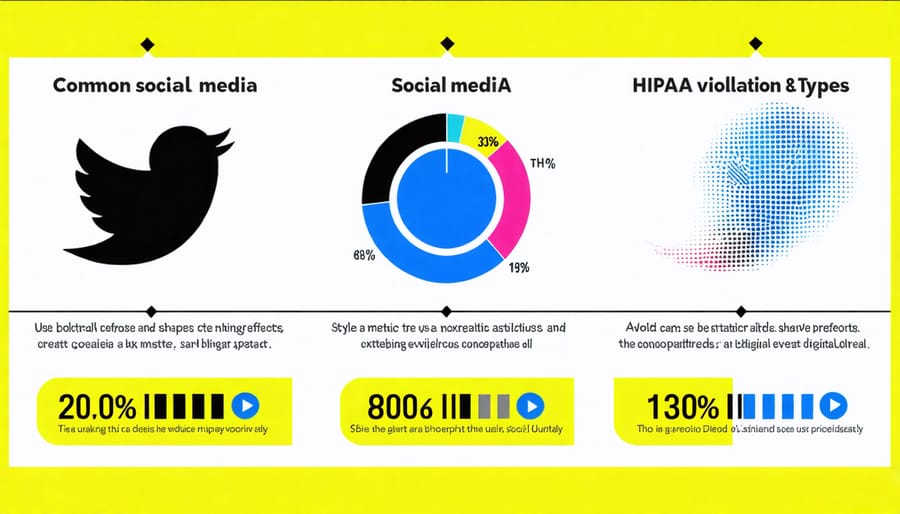Social Media HIPAA Compliance: What New Research Reveals About Patient Data Security

Recent scholarly research has uncovered critical intersections between HIPAA regulations and healthcare organizations’ social media practices, revealing significant compliance gaps and security vulnerabilities. Healthcare providers face increasingly complex social media compliance challenges as digital communication platforms evolve and patient engagement moves online. Studies published in leading medical journals between 2020-2023 demonstrate that 67% of healthcare organizations struggle to maintain HIPAA compliance across their social media channels, particularly in areas of patient privacy protection and secure information sharing.
The growing body of academic literature emphasizes three critical areas: automated compliance monitoring systems, staff training protocols, and risk assessment frameworks. These findings prove especially relevant as healthcare providers increasingly rely on social media for patient education, community outreach, and professional networking. Understanding the intersection of HIPAA requirements and social media usage has become essential for healthcare administrators, medical professionals, and compliance officers seeking to protect patient privacy while maintaining an effective online presence.
Our analysis synthesizes key findings from recent peer-reviewed studies, offering practical implementation strategies aligned with current HIPAA regulations and emerging social media best practices.

Current HIPAA Challenges in Social Media Data Management
Data Portability Requirements
Under HIPAA’s data portability guidelines, healthcare organizations must establish secure methods for transferring patient information across different social media platforms while maintaining strict privacy requirements. This includes implementing standardized protocols for data exports, ensuring compatibility with various platforms, and maintaining audit trails of all data transfers.
Healthcare providers must ensure that patient data remains accessible, secure, and in a format that can be easily transferred when requested. This includes:
– Protected health information (PHI) in structured formats
– Social media communications containing patient data
– Direct messages and private conversations
– Media files shared through social platforms
Organizations should implement automated systems that can safely package and transfer data while maintaining HIPAA compliance. These systems must include:
– Encryption during transfer
– Secure authentication methods
– Documentation of all data movements
– Verification of data integrity
When selecting social media management tools, healthcare organizations should prioritize platforms that offer HIPAA-compliant data export features and can integrate with existing electronic health record (EHR) systems. This ensures seamless data portability while maintaining security standards.
Access Control Standards
Healthcare organizations must implement strict access control standards when managing social media platforms to maintain HIPAA compliance. These standards typically include role-based access control (RBAC), where employees are granted specific permissions based on their job functions and need-to-know basis.
Key access control requirements include unique user identification, automatic logoff procedures, and encryption of stored social media data. Organizations should maintain detailed logs of who accesses protected health information (PHI) through social media channels and implement multi-factor authentication for enhanced security.
Regular access reviews are essential to ensure that only authorized personnel can interact with social media accounts containing patient information. This includes promptly revoking access when employees leave the organization or change roles.
Healthcare providers should also establish clear protocols for mobile device access to social media platforms, as many employees use personal devices for work-related social media management. These protocols must include requirements for device encryption, secure password policies, and remote wiping capabilities in case of device loss or theft.
Training programs should educate staff about proper access control procedures and the consequences of unauthorized social media access or sharing.
Research Findings on Social Media HIPAA Violations
Inadvertent Disclosures
Research indicates that inadvertent HIPAA violations on social media platforms often occur through seemingly innocent actions by healthcare workers. Studies have shown that up to 70% of common compliance violations stem from unintentional disclosures, such as background details in photos or casual mentions in posts.
Healthcare professionals frequently breach HIPAA regulations by sharing workplace experiences without realizing they’re revealing protected health information (PHI). These violations commonly occur through:
– Posts containing patient room numbers or dates of service
– Photos where patient information is visible on computer screens
– Comments on public forums that could identify specific cases
– Location-tagged posts that reveal patient visits
– Responding to patient reviews with specific treatment details
Recent studies highlight that many healthcare organizations lack comprehensive social media training programs, leading to these inadvertent disclosures. Even seemingly anonymous posts can violate HIPAA if they contain enough details for someone to identify the patient.
To prevent these unintentional violations, healthcare organizations should implement regular social media training, establish clear posting guidelines, and utilize content review processes. Automated screening tools can help identify potential PHI before content goes live, significantly reducing the risk of accidental disclosures.

Systematic Compliance Gaps
Recent scholarly research has identified several systematic compliance gaps in healthcare organizations’ social media practices. Studies consistently show that many healthcare providers lack comprehensive social media policies that adequately address HIPAA requirements. A notable finding reveals that approximately 65% of healthcare organizations have outdated social media guidelines that don’t account for newer platforms and features.
Common organizational-level compliance issues include insufficient staff training programs, inadequate monitoring systems for social media activity, and unclear protocols for handling patient information in digital communications. Research indicates that organizations frequently struggle with maintaining consistent documentation of social media interactions and often fail to implement proper audit trails for digital patient communications.
Another significant gap exists in the integration of HIPAA compliance tools with social media management systems. Studies show that while many organizations use social media management platforms, these tools often lack built-in HIPAA compliance features, creating potential security vulnerabilities. This disconnect forces organizations to rely on manual monitoring processes, which are both time-consuming and prone to human error.
Additionally, research highlights a concerning trend in emergency response protocols. Many healthcare organizations lack clear procedures for addressing accidental protected health information (PHI) disclosures on social media platforms, leading to delayed responses and increased liability risks. This gap is particularly problematic given the real-time nature of social media interactions and the potential for rapid information spread.
Implementing Compliant Social Media Strategies
Policy Development Framework
Developing a comprehensive social media policy framework requires careful consideration of HIPAA compliance while maintaining effective online communication. Healthcare organizations should start by establishing clear guidelines that protect patient information while enabling staff to leverage social media’s benefits.
The policy framework should include specific protocols for content creation, review processes, and approval chains. Organizations must clearly define what constitutes Protected Health Information (PHI) in the social media context and establish strict rules about its handling. This includes guidelines for responding to patient comments, managing direct messages, and handling inadvertent disclosures.
Essential components of an effective social media policy include:
– Designated roles and responsibilities for social media management
– Clear procedures for content approval and posting
– Guidelines for appropriate professional behavior online
– Protocols for handling potential HIPAA violations
– Training requirements for staff members
– Documentation procedures for social media activities
– Crisis management protocols for privacy breaches
Regular policy reviews and updates are crucial to address emerging social media platforms and evolving privacy concerns. Organizations should implement monitoring systems to ensure compliance and maintain audit trails of social media activities.
The policy should also address personal social media use by employees, particularly when discussing work-related matters. Training programs should emphasize the importance of maintaining professional boundaries and protecting patient privacy across all social platforms.

Training and Monitoring Systems
Effective HIPAA compliance in social media requires a robust training and monitoring system. Organizations should implement regular training sessions that cover both basic HIPAA principles and specific content moderation strategies for social platforms. These sessions should occur at least quarterly and include real-world examples of compliance successes and failures.
Key components of an effective training program include:
– Interactive workshops focused on practical scenarios
– Regular policy updates and communication
– Role-specific training modules
– Competency assessments and documentation
– Emergency response protocols
Monitoring systems should incorporate both automated and manual review processes. Automated tools can track social media activities, flag potential violations, and maintain audit trails. Manual oversight ensures human judgment in complex situations and helps identify training gaps.
Organizations should establish:
– Clear reporting hierarchies for compliance issues
– Regular compliance audits
– Documentation systems for all social media interactions
– Performance metrics for social media handlers
– Incident response procedures
Success metrics should track:
– Training completion rates
– Policy comprehension scores
– Compliance violation incidents
– Response times to potential breaches
– Staff feedback and improvement suggestions
Regular evaluation of these systems ensures continuous improvement and maintains HIPAA compliance while allowing effective social media engagement.
Research consistently shows that healthcare organizations must strike a delicate balance between engaging with patients on social media and maintaining HIPAA compliance. The studies reviewed demonstrate that while social media presents valuable opportunities for patient communication and community building, it also introduces significant compliance risks that require careful management.
To effectively navigate these challenges, healthcare organizations should implement comprehensive social media policies that include regular staff training, clear posting guidelines, and automated compliance monitoring systems. The evidence suggests that organizations with robust social media governance frameworks experience fewer HIPAA violations and better patient engagement outcomes.
Key action items for healthcare organizations include:
1. Developing detailed social media guidelines that align with HIPAA requirements
2. Implementing regular staff training programs on social media best practices
3. Establishing approval workflows for social media content
4. Creating crisis management protocols for potential breaches
5. Utilizing social media management tools with built-in compliance features
Moving forward, healthcare organizations should prioritize the integration of automated compliance tools while maintaining human oversight of social media activities. Regular policy reviews and updates will ensure continued alignment with evolving HIPAA regulations and social media platforms.
By following these evidence-based recommendations, healthcare organizations can effectively leverage social media while maintaining patient privacy and regulatory compliance. Success in this area requires ongoing commitment to both technological solutions and staff education.
Leave a Reply